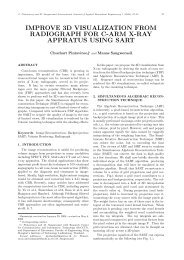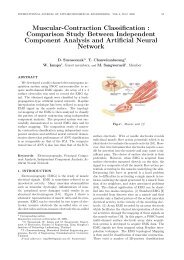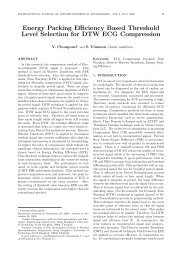Discrete Wavelet Transform-based Baseline Wandering ... - ijabme.org
Discrete Wavelet Transform-based Baseline Wandering ... - ijabme.org
Discrete Wavelet Transform-based Baseline Wandering ... - ijabme.org
Create successful ePaper yourself
Turn your PDF publications into a flip-book with our unique Google optimized e-Paper software.
28 C. Bunluechokchai and T. Leeudomwong: <strong>Discrete</strong> <strong>Wavelet</strong> <strong>Transform</strong>-<strong>based</strong> <strong>Baseline</strong> .... (26-31)<br />
Fig.2: ECG signals with baseline wandering from<br />
a subject with myocardial infraction for X, Y, and Z<br />
leads.<br />
Fig.3: The magnified segments in Figure 2 for X,<br />
Y, and Z leads.<br />
Following baseline wandering removal, the synthesized<br />
XYZ leads were used to form the vector magnitude,<br />
as recommended in the Simson method. The<br />
three parameter measurements were then computed.<br />
Figure 8 displays the vector magnitude of the myocardial<br />
infraction patient with the three parameter<br />
measurements. The three parameters of this patient<br />
were the QRS duration of 158 ms, RMS40 of 8.04<br />
µV, and LAS40 of 79 ms. It means that this patient<br />
showed the presence of VLPs. Moreover, Figure 9 illustrates<br />
the ECG signals from a healthy subject for<br />
X, Y, and Z leads, respectively. It can be observed<br />
that baseline wandering occured in the ECG signals.<br />
Fig.4: Results of DWT decomposition and synthesis<br />
of the X lead at level 10.<br />
The Y lead showed the large baseline wandering. The<br />
level 10 DWT decomposition and reconstruction of<br />
the ECG signals in Figure 9 were performed, as mentioned<br />
above. As a result, Figure 10 displays the ECG<br />
signals with removal of baseline wandering for the<br />
XYZ leads, respectively. It can be seen that removal<br />
of baseline wandering of X, Y, and Z leads can be<br />
achieved. The baseline was very stable for each lead.<br />
The resulting XYZ leads were then applied to the<br />
Simson method and the vector magnitude was computed.<br />
In Figure 11, it exhibits the vector magnitude<br />
with the three parameter measurements. The three<br />
parameters were the QRS duration of 102 ms, RMS40<br />
of 22.5 µV, and LAS40 of 34 ms, suggesting that this<br />
patient did not show the presence of VLPs.<br />
In addition, another subject with myocardial infraction<br />
was investigated for the DWT-<strong>based</strong> baseline<br />
wandering removal. Figure 12 shows the ECG signals<br />
with baseline wandering for X, Y, and Z leads of this<br />
subject. In Figure 13, it plots the reconstructed XYZ<br />
leads after baseline wandering removal for X, Y, and<br />
Z leads, respectively. Figure 14 reveals the presence<br />
of VLPs computed from the vector magnitude of the<br />
synthesized XYZ leads in Figure 13.<br />
Furthermore, another normal subject was studied<br />
for the removal of ECG baseline wandering. This subject<br />
displays the ECG baseline wandering, as shown<br />
in Figure 15. Figures 16 and 17 illustrate the synthesized<br />
XYZ leads and the resulting vector magnitude<br />
with the three parameters, respectively.<br />
4. DISCUSSION AND CONCLUSION<br />
Patients who have suffered myocardial infraction<br />
may undergo future life-threatening arrhythmias. It<br />
is documented that VLPs are related to patients with<br />
myocardial infraction and they have been successfully











